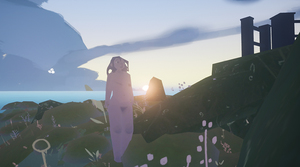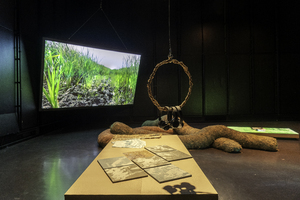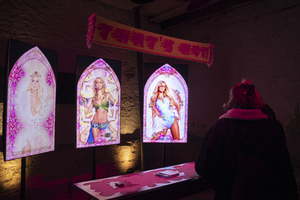G.O.T.T.A.L.I.S.T.E.N.
Benachbarte Sets (16)Alle Zusammenhänge anzeigen
Diese Sets wurden den gleichen Sets hinzugefügt wie das ausgewählte Set.
16 Inhalte
- Seite 1 von 2
The Plenum – A Scripted Play
- Titel
- The Plenum – A Scripted Play
- Autor/in
- Beschreibung (de)
- "The Plenum – A Scripted Play" behandelt das performative, das rituelle und das gemeinschaftsbildende Moment des Plenums als Planungstreffen selbstverwalteter Gruppen im politischen und kulturellen Kontext.
Über den Zeitraum eines Jahres wurden "Plena" in unterschiedlichen Konstellationen durchgeführt, die die gruppeneigene Dynamik untersuchten und auf Basis eines sich verändernden Scripts, einem Theaterdrehbuch oder Code gleichend, in einer kollektiven Performance Ausdruck fanden.
Die dabei von der Gruppe gemachten Erfahrungen dienten nicht nur zur Dokumentation für Gewesenes, sondern wurden als neuer „Input“ sofort in das bestehende Script eingearbeitet. Das sich permanent verändernde Projekt konnte so nach Vorbild eines Computerprogramms transparent gestaltet werden und ermöglichte eine basisdemokratische Beteiligung aller Akteur:innen – unabhängig von präexistentem Wissen oder Erfahrungswerten.
Nach Vorbild von Jo Freemans Essay „The Tyranny Of Structurelessness“ stand das Schaffen offener und klarer Kommunikation bezüglich der eigenen Gruppenstruktur und deren „Balance of Power“ im Mittelpunkt der Treffen.
„The Plenum – A Scripted Play“ ist jedoch nicht nur ein reales Treffen einer politischen Gruppe, sondern schafft seine identitäre Notwendigkeit durch seine Schnittstelle mit der Simulation: Das Finden von Mehrheiten (oder Einstimmigkeiten), die Verteilung von Macht und Autorität innerhalb der eigenen Gruppe sowie der Entscheidungsfindungsprozess wurden in verschiedenen Modellen spielerisch erprobt und in ihren politischen und historischen Kontext eingeordnet. Der fiktive Aspekt der Treffen öffnete Spielräume zur Reflexion über das eigene Verhalten innerhalb von Gruppengefügen. Vielen dieser Simulationen dienten Computercodes, Brettspiele und politische Verfassungen zur Vorlage.
Einem jeden Treffen selbstverwalteter Gruppen wohnt immer – oft unbewusst – etwas Rituelles inne, das zum Schaffen der kollektiven Identität von hoher Bedeutung ist. Das Wiederholen planerischer Abläufe und die kodifizierten, gruppenspezifischen Kommunikationsregeln entscheiden über Zugehörigkeit zur Gruppe und sind identitäts- und sinnstiftend.
Was vom Plenum bleibt, sind Simulationsskizzen, ein (beinahe) gegründeter Verein, eine intensive Auseinandersetzung um Vergütungsmodelle in einer nonmonetären Mikrowirtschaft und das Erarbeiten nachhaltiger Strukturen für die eigene kulturelle und politische Praxis, die sich bis heute fortsetzen. Sichtbar von alledem ist nichts, außer die Spuren, die wir stigmergisch hinterlassen.
Diese Spuren: Der Raum, in dem wir uns treffen; das Feuer, um das wir uns versammeln; die Karten, aus denen wir ablesen können, was einmal besprochen wurde – und werden wird; und das Script, ein sich permanent veränderndes Programm, das es uns vielleicht einmal ermöglichen wird, eine sozial und ökologisch nachhaltige Existenz in der Kunst- und Kulturszene zu führen.
- "The Plenum – A Scripted Play" behandelt das performative, das rituelle und das gemeinschaftsbildende Moment des Plenums als Planungstreffen selbstverwalteter Gruppen im politischen und kulturellen Kontext.
- Beschreibung (en)
- "The Plenum - A Scripted Play" deals with the performative, ritual and community-building moment of the plenum as a planning meeting of self-organised groups in a political and cultural context.
Over the course of a year, "Plena" were held in different constellations, which examined the group's own dynamics and found expression in a collective performance based on a changing script, similar to a theatre script or code.
The experiences made by the group not only served to document what had already happened, but were also immediately incorporated into the existing script as new "input". The constantly changing project could thus be designed transparently, modelled like a computer program, and enabled the grassroots democratic participation of all actors - regardless of pre-existing knowledge or experience.
Inspired by Jo Freeman's essay "The Tyranny Of Structurelessness", the creation of open and clear communication regarding the group's own structure and its "balance of power" was at the centre of the meetings.
However, "The Plenum – A Scripted Play" is not just a real meeting of a political group, but creates its identitary necessity through its intersection with the simulation: finding majorities (or unanimity), the distribution of power and authority within one's own group and the decision-making process were playfully tested in various models and placed in their political and historical context. The fictitious aspect of the meetings opened up scope for reflection on one's own behaviour within group structures. Many of these simulations were based on computer codes, board games and political constitutions.
There is always – often unconsciously – something of ritual inherent to every meeting of self-governed groups, which is of great importance for creating a collective sense of identity. The repetition of planning processes and the codified, group-specific communication rules determine membership of the group and create identity and purpose.
What remains of the plenum are simulation sketches, an (almost) founded association, an intensive debate about remuneration models in a non-monetary micro-economy and the development of sustainable structures for one's own cultural and political practice, which continue to this day. None of this is visible, except for the traces that we stigmergically leave behind.
These traces: the space in which we meet; the fire around which we gather; the cards from which we can read what has been – and will be – discussed; and the script, a constantly changing programme that will perhaps one day enable us to lead a socially and ecologically sustainable existence in the world of art and culture.
- "The Plenum - A Scripted Play" deals with the performative, ritual and community-building moment of the plenum as a planning meeting of self-organised groups in a political and cultural context.
- Kategorie
- Typ des Projekts/Werks
- Datierung
- 07.03.2023 - 18.04.2024
- Sprache
- Ort
- Plenarwohnung, Atelier von K.-J. Overkott, Günther-Klotz-Anlage, Schlosspark, Stephanienstraße (bei Sven), Sophienstraße (bei Tim), auf dem Dach, ßpace.
- Stadt
- Land
- Titel
- The Plenum – A Scripted Play
- Projektleiter/in
- Studiengang
- Typ der Abschlussarbeit
- Importiert am
- 16.06.2024
- Übergeordnete Sets
- 1
- Set enthält
- 0 6
Vakna
- Titel
- Vakna
- Titel (en)
- Vakna
- Untertitel
- Der menschliche Körper. Das Wiederentdecken. Das Akzeptieren. Das Erwachen
- Autor/in
- Beschreibung (de)
- Der menschliche Körper.
Das Wiederentdecken.
Das Akzeptieren.
Das Erwachen.
Diese Gedanken sind der Beginn des Spiels Vakna, einer Gedankenwelt, die sich mit der Wahrnehmung und der Akzeptanz des unbekleideten menschlichen Körpers befasst und dadurch gesellschaftliche Einflüsse hinterfragt.
In dieser Gedankenwelt ist es dem/der Spieler/in möglich durch auffindbare Fragen und Aussagen mehr über sich selbst, die eigene Wahrnehmung, das eigene Verhalten, die eigene Moral und die eigenen rituellen Gedankengänge den menschlichen Körper betreffend herauszufinden.
Die Gedankenwelt Vakna erwacht gemeinsam mit der spielenden Person, welche vielleicht beginnt die eigene Wahrnehmung, das eigene Verhalten, die eigene Moral und die eigenen rituellen Gedankengänge den menschlichen Körper betreffend zu hinterfragen, für sich selbst und gegenüber anderen Menschen neu zu ordnen oder zu verändern.
Am Ende dieses Spiels hat jede Person für sich selbst zu entscheiden, ob das Wiedererwachen des Körpers und damit verbundene „Neu-Erleben“ der Welt ausprobiert oder gelebt werden möchte.
Auch sind die Fragen zu beantworten, wie mit der neugewonnen Akzeptanz und Wiederentdeckung umzugehen ist. Doch hat die spielende Person bei dieser Entscheidung sich nicht dem Spiel gegenüber zu verantworten, sondern sich selbst und den Mitmenschen der Gesellschaft.
Bei diesem Computerspiel handelt es sich um einen Single-Player im Bereich der Serious- und Educational-Games, das mit Tastatur und Maus gespielt werden kann.
- Der menschliche Körper.
- Beschreibung (en)
- The human Body.
The Rediscovery.
The Accepting.
The Awakening.
These thoughts are the beginning of the game Vakna, a world of thoughts that deals with the perception and acceptance of the human body without clothes, thereby questioning social influences.
In this world of thoughts it is possible for the player to find out more about himself, his own perception, his own behavior, his own morality and his own ritual thoughts concerning the human body through discoverable questions and statements.
Vakna awakens together with the player. The player begins to question the own perception, the own behavior, the own morality and the own ritual thought processes concerning the human body and perhaps to rearrange or change them for themselves and for other people.
At the end of this game, each person has to decide for himself whether the body's reawakening and the „re-experiencing“ of the world would be tried out or lived.
Also, the questions to be answered are how to deal with the newly gained acceptance and rediscovery. But in this decision, the player does not have to answer to the game, but to himself and the fellow human beings of society.
This computer game is a single player in the field of serious and educational games that can be played with a keyboard and a mouse.
- The human Body.
- Typ des Projekts/Werks
- Schlagworte
- Datierung
- 21.11.2018
- Mitwirkende
- Sprache
- Material
- Technik/Verfahren/Formate
- Computerspiel für Windows
- Abmessungen
- 3D
- Ort
- Hochschule für Gestaltung Karlsruhe
- Stadt
- Land
- Internetlinks
- Titel
- Vakna
- Importiert am
- 16.11.2018
- Übergeordnete Sets
- 1
- Set enthält
- 1 21
"Wet again"
- Titel
- "Wet again"
- Untertitel
- Wahrnehmung und Abstraktion von Erhaltungsarbeit im ländlichen Raum
- Untertitel des Projekts/Werks (en)
- Perception and abstraction of maintenance work in the rural
- Autor/in
- Beschreibung (de)
- „Wet again“ ist das Ergebnis eines zweijährigen Prozess von Laura Haak, eine Moorregion als Akteur
wahrzunehmen und zu begleiten. Es liegt in einem abgelegenen Terrain im Nordosten Deutschlands nahe dem
Kummerower See im Malchiner Umland.
In einer Feldforschung wurde viel Zeit verbracht, Scores der Zusammenarbeit entwickelt, Wander und Kanu Routen 1:1 erschlossen. Dabei entstand ein Austausch mit den Menschen vor Ort, die eine längere Beziehung zum Torfboden pflegen und sich für die Wiedervernässung von Moorböden lokal und europaweit einsetzen.
Es entstand ein Gewebe aus verschiedenen Wahrnehmungsperspektiven und die Frage nach ihren machtpolitischen Auswirkungen auf ländliche Gestaltungsprozesse.Was sind die neuen Choreografien der Erhaltungsarbeit, auf welche Perspektiven wird Bezug genommen?
Auf mehreren Testfeldern der Universität Greifswald und des Greifswald Moor Instituts werden aktuell Daten gesammelt, die zu einer Umstellung der europäischen Subventionierung von Moorkulturen genutzt werden. Lokale Archivmaterialien über einen Hexenprozess, hochstaplerische Ritterbrüder aus Lüneburg und DDR Fdj Jugendcamps für staatliche Meliorationsvorhaben geben Einblick in die historische Dimensionen.
Lokale Künstler und Umweltwissenschaftler schaffen Austauschorte für ökologisch bezogene Kulturarbeit.
Landwirte die mit den sehr existenziellen Fragen der direkten Übersetzung der Ideen konfrontiert sind,-und über 5000 Jahre intakte Bodenproben die als eigenes Archiv eine noch viel längere viel größere Geschichte zu erzählen haben.
Eindrücke und Materialien dieser Zeit verarbeitet Laura Haak in einer Installation aus 4 unterschiedlich langen Videoessays mit immersiver Soundcollage, bedruckten lokal hergestellten Grasfaserplatten, einer Projektionsfläche aus Agaragar und Paludikulturen und einer Sitzinstallation aus 130kg Seggenrohrgras
der vor Ort gefilmten Felder.
Ein Reader mit gesammelten Materialien und textlichen Einordnungen inspiriert von Essays von Tim Ingold schlägt eine Dramaturgie vor, die im Sinne der eigenen Wahrnehmung verworfen werden kann.
- „Wet again“ ist das Ergebnis eines zweijährigen Prozess von Laura Haak, eine Moorregion als Akteur
- Beschreibung (en)
- ‘Wet again’ is the result of a two-year process by Laura Haak to perceive and accompany a moorland region as an acting entity.
It is located in a remote area in north-eastern Germany near Lake Kummerow in the Surrounding Malchin.
A lot of time was spent conducting field research, developing scores of collaboration, and tracing hiking and canoe routes 1:1.
This led to an exchange with local people who have a long-standing relationship with the peat soil and are committed to the rewetting of moorland soils both locally and across Europe.
A fabric of different perspectives emerged, along with questions about their power-political implications for rural design processes. What are the new choreographies of maintenance work, and what perspectives are being referred to?
Data is currently being collected at several test sites at the University of Greifswald and the Greifswald Moor Institute, which will be used to change European subsidies for moorland cultivation. Local archive materials about a witch trial, impostor knights from Lüneburg and GDR Fdj youth camps for national drainage projects provide insight into the historical dimensions.
Local artists and environmental scientists are creating places of exchange for ecologically-related cultural work.
Farmers who are confronted with the very existential questions of directly translating ideas,- And over 5,000 years intact soil samples that, as an archive in their own, have an even longer and much greater story to tell.
Laura Haak processes impressions and materials from this period in an installation consisting of four video essays of varying lengths with an immersive sound collage, printed locally produced grass fibre boards, a projection surface made of agar agar and paludicultures, and a seating installation made of 130 kg of sedge grass
from the fields filmed on site.
A reader with collected materials and textual classifications inspired by essays by Tim Ingold suggests a dramaturgy that can be discarded in the sense of one's own perception.
- ‘Wet again’ is the result of a two-year process by Laura Haak to perceive and accompany a moorland region as an acting entity.
- Kategorie
- Typ des Projekts/Werks
- Schlagworte
- Datierung
- Zwei Sommer und ein Frühjahr 2023-2025
- Sprache
- Ort
- Achknoledgements:
Dr Uta Berghöfer, Dr Joachim Borner Martina Zienert
from Projekthof Karnitz , Nora Köhn from University
Greifswald, Dr Ulf Schiefelbein from Ministry for
Climate Protection, Agriculture, Rural Areas and
the Environment Mecklenburg-Western Pomerania
, Tobias Dahms from thermal drones GmbH, Richard
Hurding from Zelfo Technology GmbH, the paludi
farmers Ludwig Bork and Henning Voigt,
Frank Zimmermann from "Uns lütt Museum“ Dargun
and sculptor Kathrin Wetzel for their time and
willingness to show themselves, interesting and
realizing conversations, the opportunity for a bird‘s eye
view and 150 kilograms of sedge cane grass,
Tim
Ingolds for loaning captions and providing impulses
for thoughts and perception
Celine Condorelli, Jaya Demmer, Lina Determann, Mascha Dilger, Benjamin Eisele, Constanze Fischbeck, Hanna Franke, Vera Gärtner, Marlene-, Michael-, Birgit- and Michaela Haak, Mira Hirtz, Franka Kampmeier, Alexander Knoppig, Hanne König, Christian‘Lübben, Leonie Mühlen, Wiebke Muller, Leonie Müller, Laura Morcillo and ZeitBildLab, Luise Peschko, Nis Petersen, Sebastian Schafer, Susanne Schmitt, Josefine Scheu, Phillip Schell, Arthur Schuman, Henriette Schwabe, Claud Teichmann, Alexander Thelen, Johannes Thimm, Leia Walz, Isabel Winter for countless support, the best of times, carrying hands, attentive eyes and continuous inquiries and Paulina Mimberg for the most splendid graphic.
- Achknoledgements:
- Titel
- "Wet again"
- Projektleiter/in
- Semester
- Studiengang
- Typ der Abschlussarbeit
- Importiert am
- 30.06.2025
- Übergeordnete Sets
- 0
- Set enthält
- 2 3
WHERE LEGENDS ARE MADE AND LIES ARE TOLD
- Titel
- WHERE LEGENDS ARE MADE AND LIES ARE TOLD
- Autor/in
- Beschreibung (de)
- WHERE LEGENDS ARE MADE AND LIES ARE TOLD (graduation project). Originated by this divine union of @parishilton @britneyspears @lindsaylohan (aka the Holy Trinity <3) the night of the infamous Bimbo Summit, WLAMALAT is the visual and critical translation of my obsession for the #y2k it-girls and #popculture in general. Mixing a religious with a highly commercial aesthetic, the project questions several topics such as women representation in the mass media, visual/celebrity culture consumption and new belief systems.
- WHERE LEGENDS ARE MADE AND LIES ARE TOLD (graduation project). Originated by this divine union of @parishilton @britneyspears @lindsaylohan (aka the Holy Trinity <3) the night of the infamous Bimbo Summit, WLAMALAT is the visual and critical translation of my obsession for the #y2k it-girls and #popculture in general. Mixing a religious with a highly commercial aesthetic, the project questions several topics such as women representation in the mass media, visual/celebrity culture consumption and new belief systems.
- Beschreibung (en)
- WHERE LEGENDS ARE MADE AND LIES ARE TOLD (graduation project). Originated by this divine union of @parishilton @britneyspears @lindsaylohan (aka the Holy Trinity <3) the night of the infamous Bimbo Summit, WLAMALAT is the visual and critical translation of my obsession for the #y2k it-girls and #popculture in general. Mixing a religious with a highly commercial aesthetic, the project questions several topics such as women representation in the mass media, visual/celebrity culture consumption and new belief systems.
- WHERE LEGENDS ARE MADE AND LIES ARE TOLD (graduation project). Originated by this divine union of @parishilton @britneyspears @lindsaylohan (aka the Holy Trinity <3) the night of the infamous Bimbo Summit, WLAMALAT is the visual and critical translation of my obsession for the #y2k it-girls and #popculture in general. Mixing a religious with a highly commercial aesthetic, the project questions several topics such as women representation in the mass media, visual/celebrity culture consumption and new belief systems.
- Kategorie
- Typ des Projekts/Werks
- Datierung
- 06.12.23
- Dank an
- Ort
- Rudolf 5
- Titel
- WHERE LEGENDS ARE MADE AND LIES ARE TOLD
- Projektleiter/in
- Semester
- Studiengang
- Typ der Abschlussarbeit
- Importiert am
- 05.11.2024
- Übergeordnete Sets
- 1
- Set enthält
- 3 8



